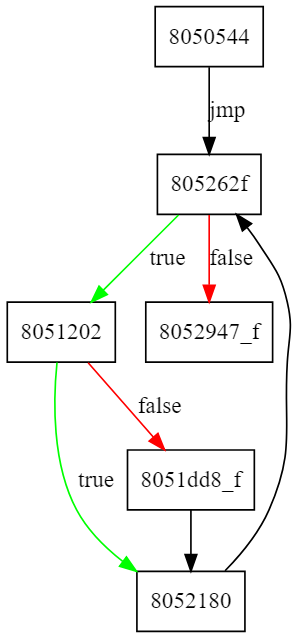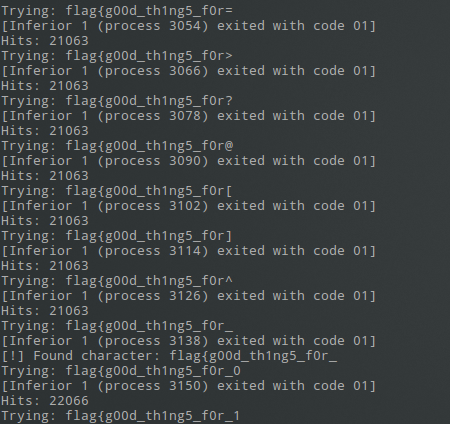Problem Description
Deep on the web, I discovered a secret key validation. It appeared to be from the future, and it only had one sentence: “Risk speed for security”. Something seems fishy, you should try to break the key and find the secret inside!
The binary
Welp, this binary was movfuscated:
08048794 <check_element>:
8048794: a1 88 d2 3f 08 mov eax,ds:0x83fd288
8048799: ba 94 87 04 88 mov edx,0x88048794
804879e: a3 10 d1 1f 08 mov ds:0x81fd110,eax
80487a3: 89 15 14 d1 1f 08 mov DWORD PTR ds:0x81fd114,edx
80487a9: b8 00 00 00 00 mov eax,0x0
80487ae: b9 00 00 00 00 mov ecx,0x0
80487b3: ba 00 00 00 00 mov edx,0x0
80487b8: a0 10 d1 1f 08 mov al,ds:0x81fd110
80487bd: 8b 0c 85 20 77 05 08 mov ecx,DWORD PTR [eax*4+0x8057720]
80487c4: 8a 15 14 d1 1f 08 mov dl,BYTE PTR ds:0x81fd114
80487ca: 8a 14 11 mov dl,BYTE PTR [ecx+edx*1]
80487cd: 89 15 00 d1 1f 08 mov DWORD PTR ds:0x81fd100,edx
80487d3: a0 11 d1 1f 08 mov al,ds:0x81fd111
80487d8: 8b 0c 85 20 77 05 08 mov ecx,DWORD PTR [eax*4+0x8057720]
80487df: 8a 15 15 d1 1f 08 mov dl,BYTE PTR ds:0x81fd115
80487e5: 8a 14 11 mov dl,BYTE PTR [ecx+edx*1]
80487e8: 89 15 04 d1 1f 08 mov DWORD PTR ds:0x81fd104,edx
80487ee: a0 12 d1 1f 08 mov al,ds:0x81fd112
80487f3: 8b 0c 85 20 77 05 08 mov ecx,DWORD PTR [eax*4+0x8057720]
80487fa: 8a 15 16 d1 1f 08 mov dl,BYTE PTR ds:0x81fd116
Initially we tried using demovfuscator
but all this really did was turn a few movs into leas but nothing too
useful.
Instead, we used demovfuscator’s -g option to generate the control flow
graph of the program which looked like this:

Since the program was exiting on a wrong input, I decided to experiment by
adding a breakpoint at the first branch and take a look around in gdb. This
breakpoint was being hit thousands of times so I used ignore <bp> 1000000 to
quickly check how many times which resulted in a really interesting output:
flag{
[Inferior 1 (process 24054) exited with code 01]
pwndbg> i breakpoints
Num Type Disp Enb Address What
2 breakpoint keep y 0x0805262f <main+8901>
breakpoint already hit 6018 times
fla__
[Inferior 1 (process 24082) exited with code 01]
pwndbg> i breakpoint
Num Type Disp Enb Address What
3 breakpoint keep y 0x0805262f <main+8901>
breakpoint already hit 4012 times
Notice that when correct input is provided, the breakpoint is hit more often. Now that we have an indicator to know that one character of input is correct, we can go ahead and exploit this to recover the flag.
(Note: handle SIGSEGV nostop noprint pass and
handle SIGILL nostop noprint pass are required to debug in gdb since
movfuscator uses signal handlers on SIGSEGV and SIGILL for function calls and
loops)
Exploiting the side channel
We whipped up a quick gdb script to automate the process of monitoring the breakpoints:
import gdb
import string
valid_chars = string.printable
gdb.execute("file future_fun")
gdb.execute("handle SIGSEGV nostop noprint pass")
gdb.execute("handle SIGILL nostop noprint pass")
class MyBreakpoint(gdb.Breakpoint):
def stop(self):
return False
bp = MyBreakpoint("*0x805262f")
bp.ignore_count = 90000000
flag = ""
while not flag.endswith("}"):
for char in valid_chars:
bp.hit_count = 0
newflag = flag + char
with open("flagfile", "w") as f:
f.write(newflag + "%")
f.write('\n')
exec_command = 'r < flagfile > /dev/null'
gdb.write("Trying: " + newflag + "\n")
gdb.execute(exec_command)
if bp.hit_count > (len(newflag) + 1) * 1000:
gdb.write("[!] Found character: " + newflag + "\n")
flag = newflag
break
else:
gdb.write("Hits: {}\n".format(bp.hit_count))
pass
This script tries each printable character and if we hit the breakpoint a thousand times more than the last, we know it was correct.
After running for a few minutes, the flag was recovered successfully.
